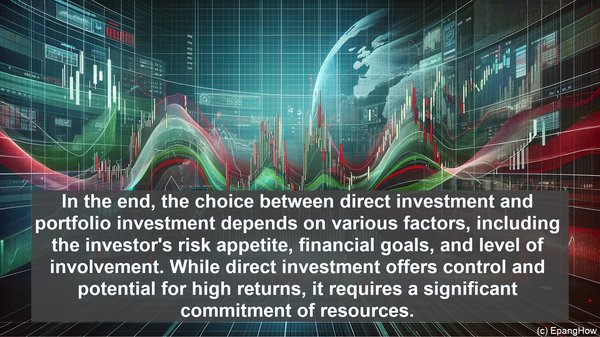Introduction: The World of Investment
Hello, and welcome to our article on the distinction between direct investment and portfolio investment. In today’s interconnected world, investment has become an integral part of our financial landscape. From individuals to multinational corporations, everyone seeks to make their money work for them. However, the strategies employed can vary significantly, with direct investment and portfolio investment emerging as two prominent approaches.
Direct Investment: A Hands-On Approach
Direct investment, as the name suggests, involves directly investing in a specific asset or venture. This can take various forms, such as purchasing real estate, acquiring a business, or even starting one from scratch. The key characteristic of direct investment is the active involvement of the investor in the management and decision-making processes. This hands-on approach provides a deeper level of control and influence over the investment, but it also requires a significant commitment of time, resources, and expertise.
Portfolio Investment: Diversification and Professional Management
In contrast, portfolio investment revolves around the concept of diversification and professional management. Instead of focusing on a single asset or venture, portfolio investment involves spreading the investment across a range of assets, such as stocks, bonds, and mutual funds. This diversification serves as a risk mitigation strategy, as the performance of one asset is not solely responsible for the overall returns. Additionally, portfolio investments are often managed by professionals, such as fund managers, who possess the expertise and knowledge to make informed decisions on behalf of the investors.

Benefits and Risks: Direct Investment
Direct investment offers several advantages. Firstly, it provides a higher level of control and autonomy, allowing the investor to shape the direction and strategy of the investment. This can be particularly appealing for individuals with a specific vision or expertise in a particular industry. Furthermore, direct investments can yield substantial returns, especially if the venture or asset performs well. However, the risks associated with direct investment are equally significant. The investor bears the full brunt of any losses or setbacks, and the lack of diversification can amplify the impact of market fluctuations or industry-specific challenges.

Benefits and Risks: Portfolio Investment
Portfolio investment, on the other hand, offers its own set of benefits. The primary advantage lies in diversification. By spreading the investment across multiple assets, the risk is distributed, reducing the potential impact of any single asset’s underperformance. Additionally, portfolio investments often provide liquidity, as they can be easily bought or sold in the market. This flexibility can be crucial, especially in situations where the investor needs to access funds quickly. However, portfolio investments are not without their risks. While diversification mitigates some of the risks, it also means that the investor’s returns are tied to the overall performance of the market. External factors, such as economic conditions or geopolitical events, can significantly influence the returns.
